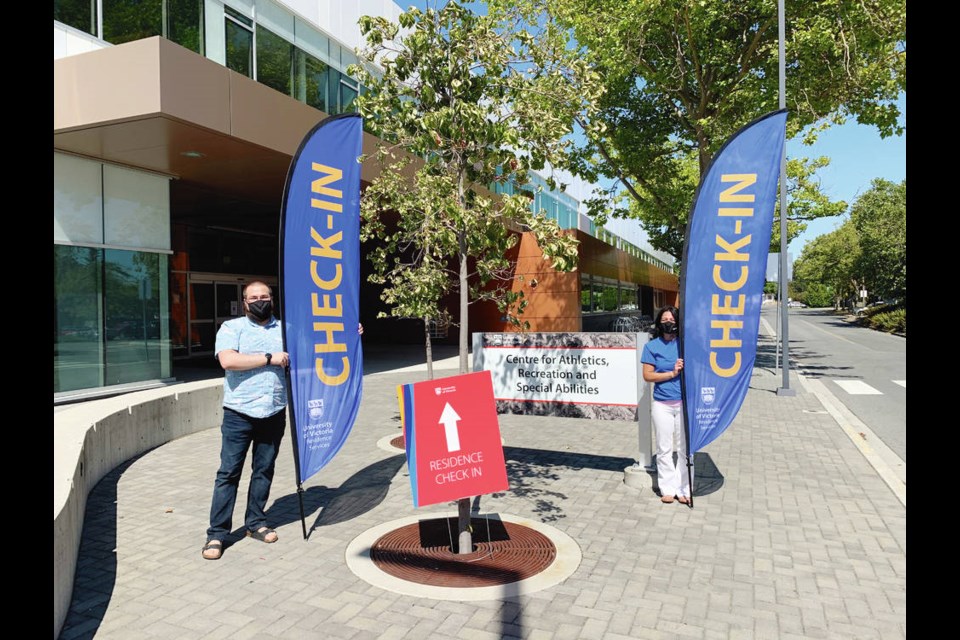PJ Matheson knows living in residence at the University of Victoria this year won’t quite match up with the stories their older sister told about her dorm life. The 18-year-old is excited to start an undergraduate program in visual arts, but a bit unsure what residence life is going to look like with COVID-19 safety precautions.
“It hasn’t been done like this before,” said Matheson, who uses gender-neutral pronouns.
Matheson is one of about 700 students moving into UVic residences on Sunday. That’s down from the usual 2,300 students living on-campus in an effort to reduce the risk of spreading COVID-19.
On Sunday, university staff and upper-year students will welcome new students in staggered intervals, with no more than 60 people scheduled in any 30-minute slot, said Rose-Marie Roxburgh, associate director of business operations in Residence Services at UVic.
UVic is limiting the number of people allowed to accompany students to two as a COVID-19 safety precaution. Matheson’s parents will help with the move from Vancouver.
Students and their helpers will be required to wear masks, Roxburgh said. Staff are also expected to wear masks.
Students will line up at two-metre intervals outside McKinnon gym and head to check-in tables set up on a basketball court in the university’s athletic centre, a much larger space than the cafeteria used in typical years.
Staff will screen students with questions about COVID-19 symptoms before they enter and take contact-tracing information for anyone accompanying the student. Anyone who fails the screening will be seen by health-service employees.
“This year, the check-in process will be slower and focused on safety, rather than speed,” Roxburgh said. After check-in, students will head to their building, where they’ll follow arrows to enter and exit.
Orientation activities on the first night in residence, where many students make their first social connections, will go ahead in small groups, online or a mix of both, she said.
Once students settle in, they’ll likely notice differences from pre-pandemic years. The university has removed furniture from lounge areas, leaving a fridge and a microwave for students to prepare food, and set capacity limits on common areas.
“It’s not going to be a place for students to hang out, unfortunately, this year. There’s occupancy limits and signs posted at every lounge,” she said.
The university has also designated spaces for students who need to self-isolate during the year, she said.
Matheson, who was prioritized for residence because some of their classes are held in-person, said the smaller number of people in residence will make the new experience less overwhelming.
“But I think once I’m adjusted, I think I’m going to miss the overall experience that it would usually be,” Matheson said.
Vancouver Island University has also adapted move-in days to stagger student arrivals. The university is expecting about 300 students to move into residence buildings before classes start, and about 60 students have already moved in, said Ian Johnsrude, the university’s manager of student housing. The remaining students will move in over four days to prevent crowding.
Johnsrude said the bulk of students would move in over two days in a normal year, with about 300 coming on the Wednesday before Labour Day and another 250 the following Saturday.
This year, students will line up in a physically distanced manner, answer questions about COVID‑19 symptoms and sanitize their hands before entering the administration building to pick up keys one at a time. “We’ve moved most of our processes to be contactless, so it really speeds up the actual interaction we have. So we’re not really anticipating any sort of line, because we’re going to be able to check in a student every two minutes,” Johnsrude said.
Only guardians will be allowed to help the student move in, and they’ll all follow arrows for one-way traffic flow through residence buildings, he said.
The university has set aside a 20-bed townhouse to be used by any students who need to self-isolate during the year. “Even if they’re not necessarily exhibiting COVID symptoms. Even if they call 811, and 811 is like, ‘Yeah, just stay away from other people.’ In a residence, we really need a place for them to go,” Johnsrude said.
The regular orientation week, filled with activities, shared meals and a keynote speaker, has transitioned to a virtual version with some small group events. “We want to connect people, whether that be virtually. We can do that the same way we did in person. It’s just learning a new set of skills and a new language to talk to our students. And so I’m really excited to see how that pans out,” Johnsrude said.
Most common areas have capacity limits of five people at a time and will be closed from 9 p.m. to 9 a.m. during the year.
Johnsrude said residence leaders are focusing on educating students on the new restrictions, and the “students that we’ve had so far have been really respectful.”
